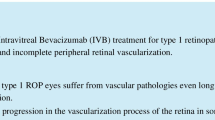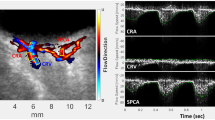Abstract
Purpose
To evaluate the relationship between ocular blood flow, expressed as mean blur rate (MBR) by laser speckle flowgraphy, and intravitreal bevacizumab (IVB) therapy in neonates with retinopathy of prematurity (ROP).
Methods
This was a case series study of 4 neonates with ROP under sedation before and after IVB and evaluated 8 eyes, in which the circulation could be measured three times consecutively. We performed optic nerve head blood flow measurement and fluorescein angiography (FA) before and 1 week after treatment. Blood flow was analyzed separately for MBR-A (mean of all values), MBR-V (vessel mean), and MBR-T (tissue mean). Comparisons between the MBR (-A, -V, -T), body weight, and other systemic and ocular parameters before and after treatment were performed using a paired t test.
Results
The MBR values after IVB were lower than the pre-treatment values in all cases. All eyes showed leakage at neovascularization on FA before treatment. Although leakage improved 1 week after treatment, the neovascularization did not completely regress.
Conclusions
IVB improves vein dilation and artery tortuosity, while reducing ocular blood flow in neonates with ROP. We suggest that neovascularization might not be involved in reducing ocular blood flow in the early stage of IVB treatment.



Similar content being viewed by others
References
Early Treatment For Retinopathy Of Prematurity Cooperative Group (2003) Revised indications for the treatment of retinopathy of prematurity: results of the early treatment for retinopathy of prematurity randomized trial. Arch Ophthalmol 121:1684–1694. https://doi.org/10.1001/archopht.121.12.1684
Hartnett ME, Martiniuk D, Byfield G, Geisen P, Zeng G, Bautch VL (2008) Neutralizing VEGF decreases tortuosity and alters endothelial cell division orientation in arterioles and veins in a rat model of ROP: relevance to plus disease. Invest Ophthalmol Vis Sci 49:3107–3114. https://doi.org/10.1167/iovs.08-1780
Baerts W, Wildervanck de Blecourt-Devilee M, Sauer PJ (1993) Ambient light, ophthalmic artery blood flow velocities and retinopathy of prematurity. Acta Paediatr 82:719–722. https://doi.org/10.1111/j.1651-2227.1993.tb12545.x
Holland DR, Saunders RA, Kagemann LE, Bluestein EC, Hutchinson AK, Corson DW, Harris A (1999) Color Doppler imaging of the central retinal artery in premature infants undergoing examination for retinopathy of prematurity. J AAPOS 3:194–198. https://doi.org/10.1016/S1091-8531(99)70002-9
Romagnoli C, Papacci P, Zecca E, Giannantonio C, De Carolis MP, Tortorolo G (2001) Normal neonatal values of ophthalmic and central retinal artery blood flow velocities. J Pediatr Ophthalmol Strabismus 38:213–217. https://doi.org/10.3928/0191-3913-20010701-07
Niwald A, Gralek M (2006) Evaluation of blood flow in the ophthalmic artery and central retinal artery in children with retinopathy of prematurity. Klin Ocz 108:32–35
Neely D, Harris A, Hynes E, McNulty L, McCranor L, Siesky B, Plager D, Sprunger D, Roberts G (2009) Longitudinal assessment of plus disease in retinopathy of prematurity using color Doppler imaging. J AAPOS 13:509–511. https://doi.org/10.1016/j.jaapos.2009.08.012
Hartenstein S, Muller B, Metze B, Czernik C, Buhrer C (2015) Blood flow assessed by color Doppler imaging in retinopathy of prematurity. J Perinatol 35:745–747. https://doi.org/10.1038/jp.2015.45
Matsumoto T, Itokawa T, Shiba T, Katayama Y, Arimura T, Mizukaki N, Yoda H, Hori Y (2015) Reproducibility of neonate ocular circulation measurements using laser speckle flowgraphy. Biomed Res Int 2015:693056. https://doi.org/10.1155/2015/693056
Matsumoto T, Itokawa T, Shiba T, Katayama Y, Arimura T, Hine K, Mizukaki N, Yoda H, Hori Y (2016) Ocular blood flow values measured by laser speckle flowgraphy correlate with the postmenstrual age of normal neonates. Graefes Arch Clin Exp Ophthalmol 254:1631–1636. https://doi.org/10.1007/s00417-016-3362-6
Matsumoto T, Itokawa T, Shiba T, Hine K, Hori Y (2017) A change in ocular circulation after photocoagulation for retinopathy of prematurity in a neonate. Case Rep Ophthalmol 8:91–98. https://doi.org/10.1159/000456708
Matsumoto T, Itokawa T, Shiba T, Tomita M, Hine K, Mizukaki N, Yoda H, Hori Y (2017) Decreased ocular blood flow after photocoagulation therapy in neonatal retinopathy of prematurity. Jpn J Ophthalmol 61:484–493. https://doi.org/10.1007/s10384-017-0536-7
Fujii H (1994) Visualisation of retinal blood flow by laser speckle flowgraphy. Med Biol Eng Comput 32:302–304. https://doi.org/10.1007/BF02512526
Aizawa N, Nitta F, Kunikata H, Sugiyama T, Ikeda T, Araie M, Nakazawa T (2014) Laser speckle and hydrogen gas clearance measurements of optic nerve circulation in albino and pigmented rabbits with or without optic disc atrophy. Invest Ophthalmol Vis Sci 55:7991–7996. https://doi.org/10.1167/iovs.14-15373
Lepore D, Quinn GE, Molle F, Baldascino A, Orazi L, Sammartino M, Purcaro V, Giannantonio C, Papacci P, Romagnoli C (2014) Intravitreal bevacizumab versus laser treatment in type 1 retinopathy of prematurity: report on fluorescein angiographic findings. Ophthalmology 121:2212–2219. https://doi.org/10.1016/j.ophtha.2014.05.015
Tahija SG, Hersetyati R, Lam GC, Kusaka S, McMenamin PG (2014) Fluorescein angiographic observations of peripheral retinal vessel growth in infants after intravitreal injection of bevacizumab as sole therapy for zone I and posterior zone II retinopathy of prematurity. Br J Ophthalmol 98:507–512. https://doi.org/10.1136/bjophthalmol-2013-304109
Lorenz B, Stieger K, Jager M, Mais C, Stieger S, Andrassi-Darida M (2017) Retinal vascular development with 0.312 mg intravitreal bevacizumab to treat severe posterior retinopathy of prematurity: a longitudinal fluorescein angiographic study. Retina 37:97–111. https://doi.org/10.1097/IAE.0000000000001126
Gunay M, Tuten A, Sancak S, Celik G, Bardak H, Dincer E, Karatekin G, Erdogan G, Bardak Y (2016) Effect of single intravitreal bevacizumab on ophthalmic and middle cerebral arterial blood flow in retinopathy of prematurity. Ophthalmic Res 55:165–171. https://doi.org/10.1159/000443208
Sato T, Kusaka S, Shimojo H, Fujikado T (2009) Vitreous levels of erythropoietin and vascular endothelial growth factor in eyes with retinopathy of prematurity. Ophthalmology 116:1599–1603. https://doi.org/10.1016/j.ophtha.2008.12.023
Matsumoto T, Saito Y, Itokawa T, Shiba T, Oba MS, Takahashi H, Hori Y (2017) Retinal VEGF levels correlate with ocular circulation measured by a laser speckle-micro system in an oxygen-induced retinopathy rat model. Graefes Arch Clin Exp Ophthalmol 255:1981–1990. https://doi.org/10.1007/s00417-017-3756-0
Yamada Y, Suzuma K, Matsumoto M, Tsuiki E, Fujikawa A, Harada T, Kitaoka T (2015) Retinal blood flow correlates to aqueous vascular endothelial growth factor in central retinal vein occlusion. Retina 35:2037–2042. https://doi.org/10.1097/IAE.0000000000000595
Matsumoto M, Suzuma K, Fukazawa Y, Yamada Y, Tsuiki E, Fujikawa A, Kitaoka T (2014) Retinal blood flow levels measured by laser speckle flowgraphy in patients who received intravitreal bevacizumab injection for macular edema secondary to central retinal vein occlusion. Retin Cases Brief Rep 8:60–66. https://doi.org/10.1097/ICB.0000000000000005
Ishida S, Usui T, Yamashiro K, Kaji Y, Ahmed E, Carrasquillo KG, Amano S, Hida T, Oguchi Y, Adamis AP (2003) VEGF164 is proinflammatory in the diabetic retina. Invest Ophthalmol Vis Sci 44:2155–2162. https://doi.org/10.1167/iovs.02-0807
Ishida S, Usui T, Yamashiro K, Kaji Y, Amano S, Ogura Y, Hida T, Oguchi Y, Ambati J, Miller JW, Gragoudas ES, Ng YS, D'Amore PA, Shima DT, Adamis AP (2003) VEGF164-mediated inflammation is required for pathological, but not physiological, ischemia-induced retinal neovascularization. J Exp Med 198:483–489. https://doi.org/10.1084/jem.20022027
Rakoczy PE, Brankov M, Fonceca A, Zaknich T, Rae BC, Lai CM (2003) Enhanced recombinant adeno-associated virus-mediated vascular endothelial growth factor expression in the adult mouse retina: a potential model for diabetic retinopathy. Diabetes 52:857–863
Edelman JL, Lutz D, Castro MR (2005) Corticosteroids inhibit VEGF-induced vascular leakage in a rabbit model of blood-retinal and blood-aqueous barrier breakdown. Exp Eye Res 80:249–258. https://doi.org/10.1016/j.exer.2004.09.013
Kaur C, Sivakumar V, Foulds WS (2006) Early response of neurons and glial cells to hypoxia in the retina. Invest Ophthalmol Vis Sci 47:1126–1141. https://doi.org/10.1167/iovs.05-0518
Tatlipinar S, Dinc UA, Yenerel NM, Gorgun E (2012) Short-term effects of a single intravitreal bevacizumab injection on retinal vessel calibre. Clin Exp Optom 95:94–98. https://doi.org/10.1111/j.1444-0938.2011.00662.x
Gelman R, Martinez-Perez ME, Vanderveen DK, Moskowitz A, Fulton AB (2005) Diagnosis of plus disease in retinopathy of prematurity using Retinal Image multiScale Analysis. Invest Ophthalmol Vis Sci 46:4734–4738. https://doi.org/10.1167/iovs.05-0646
Koreen S, Gelman R, Martinez-Perez ME, Jiang L, Berrocal AM, Hess DJ, Flynn JT, Chiang MF (2007) Evaluation of a computer-based system for plus disease diagnosis in retinopathy of prematurity. Ophthalmology 114:e59–e67. https://doi.org/10.1016/j.ophtha.2007.10.006
Chiang MF, Gelman R, Williams SL, Lee JY, Casper DS, Martinez-Perez ME, Flynn JT (2008) Plus disease in retinopathy of prematurity: development of composite images by quantification of expert opinion. Invest Ophthalmol Vis Sci 49:4064–4070. https://doi.org/10.1167/iovs.07-1524
Wittenberg LA, Jonsson NJ, Chan RV, Chiang MF (2012) Computer-based image analysis for plus disease diagnosis in retinopathy of prematurity. J Pediatr Ophthalmol Strabismus 49:11–19; quiz 10, 20. https://doi.org/10.3928/01913913-20110222-01
Campbell JP, Ataer-Cansizoglu E, Bolon-Canedo V, Bozkurt A, Erdogmus D, Kalpathy-Cramer J, Patel SN, Reynolds JD, Horowitz J, Hutcheson K, Shapiro M, Repka MX, Ferrone P, Drenser K, Martinez-Castellanos MA, Ostmo S, Jonas K, Chan RV, Chiang MF, Imaging, informatics in ROPRC (2016) Expert diagnosis of plus disease in retinopathy of prematurity from computer-based image analysis. JAMA Ophthalmol 134:651–657. https://doi.org/10.1001/jamaophthalmol.2016.0611
Funding
This work was supported by JSPS KAKENHI Grant Number JP17K11435.
Author information
Authors and Affiliations
Corresponding author
Ethics declarations
Conflict of interest
The authors declare that they have no conflict of interest.
Ethical approval
All procedures involving human participants were in accordance with the ethical standards of the institutional and/or national research committee and with the 1964 Declaration of Helsinki and its later amendments or comparable ethical standards.
Informed consent
We obtained informed consent from at least one parent of each subject.
Rights and permissions
About this article
Cite this article
Matsumoto, T., Itokawa, T., Shiba, T. et al. Intravitreal bevacizumab treatment reduces ocular blood flow in retinopathy of prematurity: a four-case report. Graefes Arch Clin Exp Ophthalmol 256, 2241–2247 (2018). https://doi.org/10.1007/s00417-018-4063-0
Received:
Revised:
Accepted:
Published:
Issue Date:
DOI: https://doi.org/10.1007/s00417-018-4063-0




